TPMS MAZDA MODEL B3000 TRUCK 2007 Owners Manual
[x] Cancel search | Manufacturer: MAZDA, Model Year: 2007, Model line: MODEL B3000 TRUCK, Model: MAZDA MODEL B3000 TRUCK 2007Pages: 280, PDF Size: 1.95 MB
Page 2 of 280
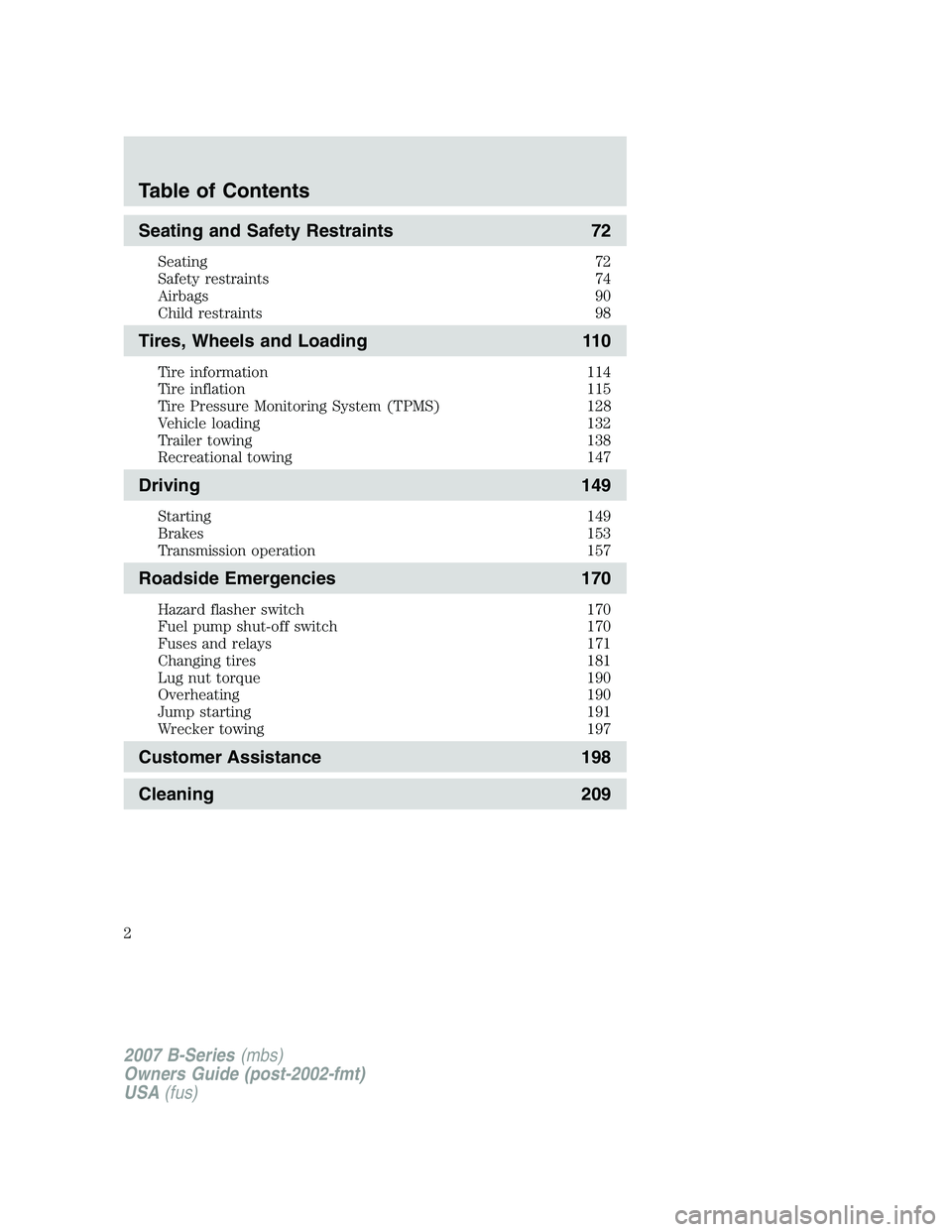
Seating and Safety Restraints72
Seating 72
Safety restraints 74
Airbags 90
Child restraints 98
Tires, Wheels and Loading110
Tire information 114
Tire inflation 115
Tire Pressure Monitoring System (TPMS) 128
Vehicle loading 132
Trailer towing 138
Recreational towing 147
Driving149
Starting 149
Brakes 153
Transmission operation 157
Roadside Emergencies170
Hazard flasher switch 170
Fuel pump shut-off switch 170
Fuses and relays 171
Changing tires 181
Lug nut torque 190
Overheating 190
Jump starting 191
Wrecker towing 197
Customer Assistance198
Cleaning 209
Table of Contents
2
2007 B-Series(mbs)
Owners Guide (post-2002-fmt)
USA (fus)
Page 119 of 280
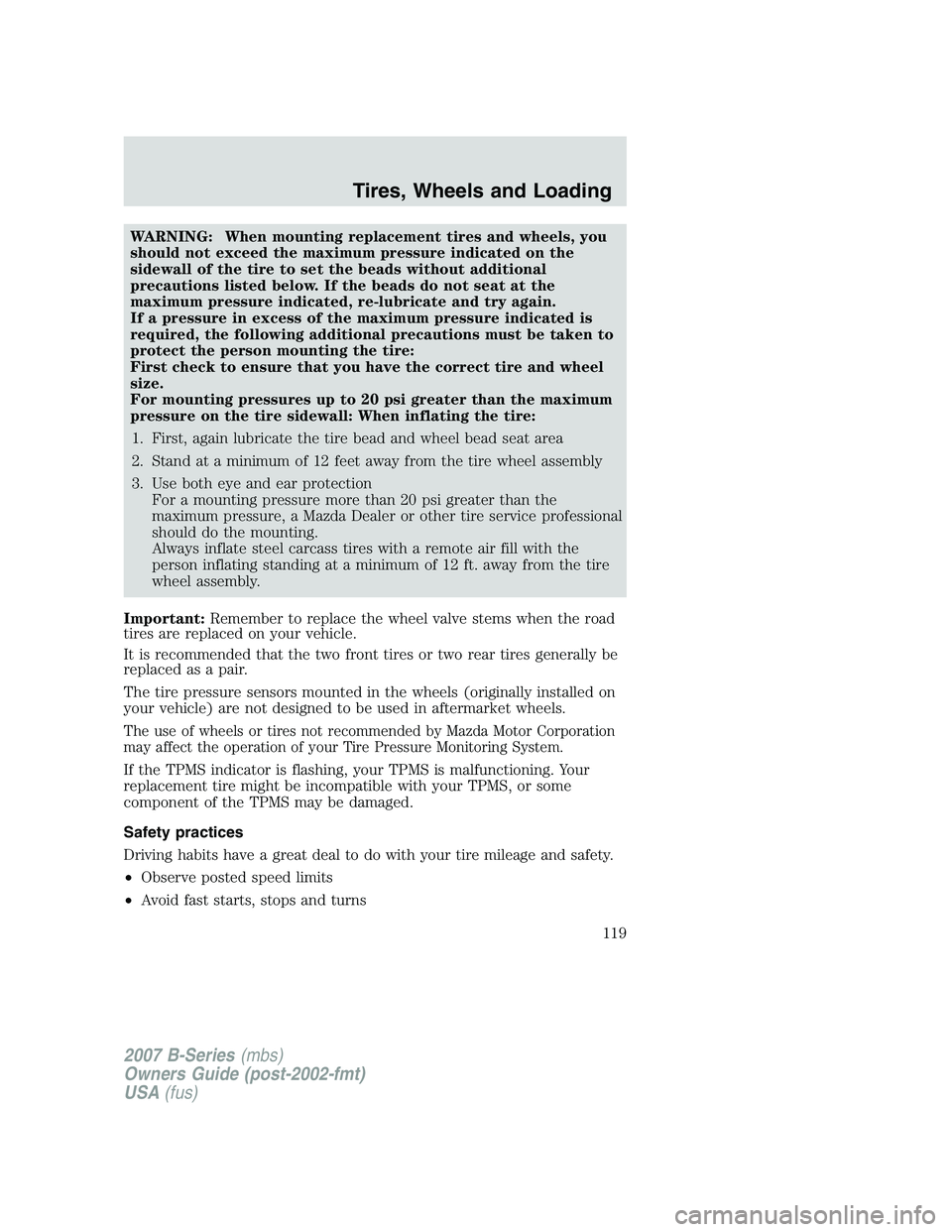
WARNING: When mounting replacement tires and wheels, you
should not exceed the maximum pressure indicated on the
sidewall of the tire to set the beads without additional
precautions listed below. If the beads do not seat at the
maximum pressure indicated, re-lubricate and try again.
If a pressure in excess of the maximum pressure indicated is
required, the following additional precautions must be taken to
protect the person mounting the tire:
First check to ensure that you have the correct tire and wheel
size.
For mounting pressures up to 20 psi greater than the maximum
pressure on the tire sidewall: When inflating the tire:1. First, again lubricate the tire bead and wheel bead seat area
2. Stand at a minimum of 12 feet away from the tire wheel assembly
3. Use both eye and ear protection For a mounting pressure more than 20 psi greater than the
maximum pressure, a Mazda Dealer or other tire service professional
should do the mounting.
Always inflate steel carcass tires with a remote air fill with the
person inflating standing at a minimum of 12 ft. away from the tire
wheel assembly.
Important: Remember to replace the wheel valve stems when the road
tires are replaced on your vehicle.
It is recommended that the two front tires or two rear tires generally be
replaced as a pair.
The tire pressure sensors mounted in the wheels (originally installed on
your vehicle) are not designed to be used in aftermarket wheels.
The use of wheels or tires not recommended by Mazda Motor Corporation
may affect the operation of your Tire Pressure Monitoring System.
If the TPMS indicator is flashing, your TPMS is malfunctioning. Your
replacement tire might be incompatible with your TPMS, or some
component of the TPMS may be damaged.
Safety practices
Driving habits have a great deal to do with your tire mileage and safety.
• Observe posted speed limits
• Avoid fast starts, stops and turns
2007 B-Series (mbs)
Owners Guide (post-2002-fmt)
USA (fus)
Tires, Wheels and Loading
119
Page 128 of 280
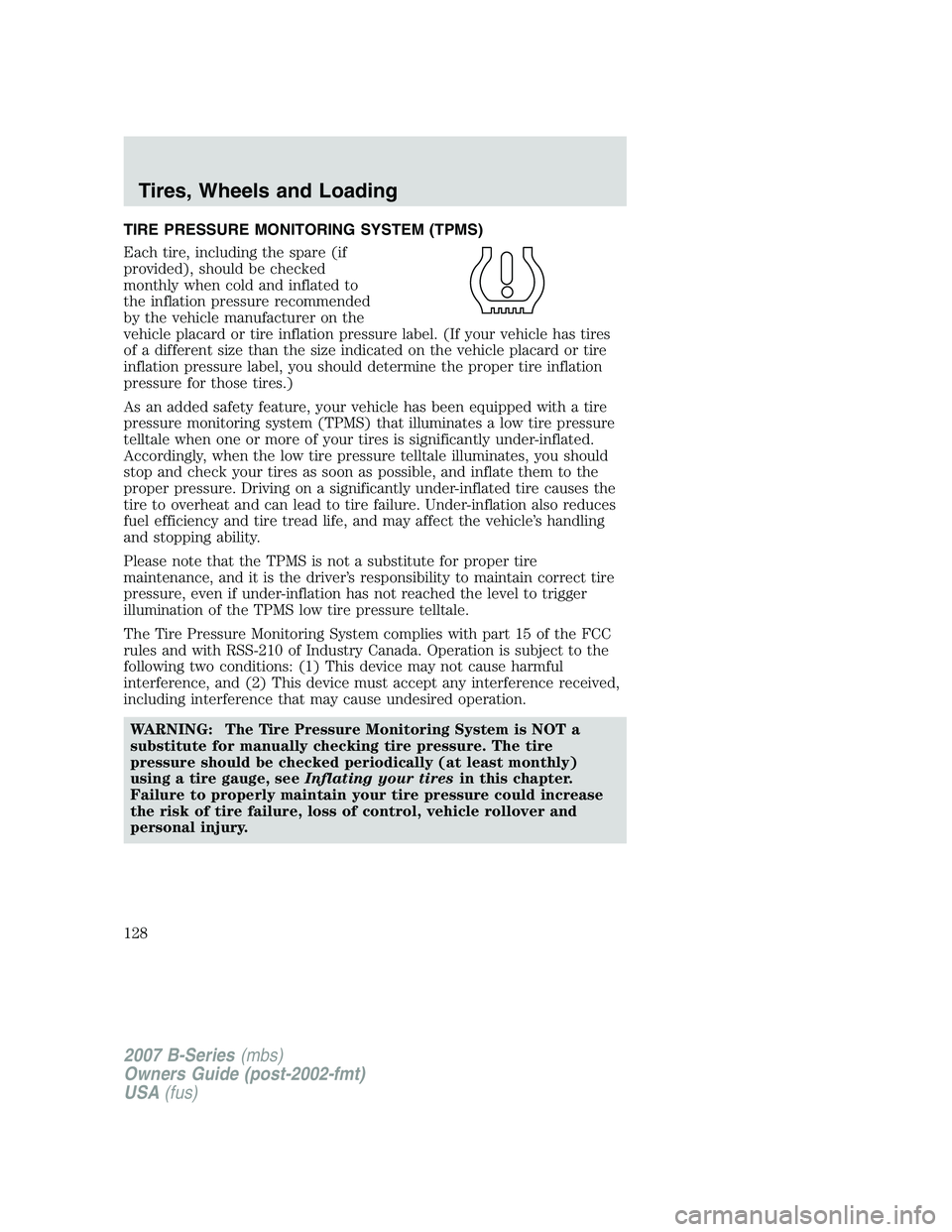
TIRE PRESSURE MONITORING SYSTEM (TPMS)
Each tire, including the spare (if
provided), should be checked
monthly when cold and inflated to
the inflation pressure recommended
by the vehicle manufacturer on the
vehicle placard or tire inflation pressure label. (If your vehicle has tires
of a different size than the size indicated on the vehicle placard or tire
inflation pressure label, you should determine the proper tire inflation
pressure for those tires.)
As an added safety feature, your vehicle has been equipped with a tire
pressure monitoring system (TPMS) that illuminates a low tire pressure
telltale when one or more of your tires is significantly under-inflated.
Accordingly, when the low tire pressure telltale illuminates, you should
stop and check your tires as soon as possible, and inflate them to the
proper pressure. Driving on a significantly under-inflated tire causes the
tire to overheat and can lead to tire failure. Under-inflation also reduces
fuel efficiency and tire tread life, and may affect the vehicle’s handling
and stopping ability.
Please note that the TPMS is not a substitute for proper tire
maintenance, and it is the driver’s responsibility to maintain correct tire
pressure, even if under-inflation has not reached the level to trigger
illumination of the TPMS low tire pressure telltale.
The Tire Pressure Monitoring System complies with part 15 of the FCC
rules and with RSS-210 of Industry Canada. Operation is subject to the
following two conditions: (1) This device may not cause harmful
interference, and (2) This device must accept any interference received,
including interference that may cause undesired operation.WARNING: The Tire Pressure Monitoring System is NOT a
substitute for manually checking tire pressure. The tire
pressure should be checked periodically (at least monthly)
using a tire gauge, see Inflating your tiresin this chapter.
Failure to properly maintain your tire pressure could increase
the risk of tire failure, loss of control, vehicle rollover and
personal injury.
2007 B-Series (mbs)
Owners Guide (post-2002-fmt)
USA (fus)
Tires, Wheels and Loading
128
Page 129 of 280

Changing tires with TPMS
Each road tire is equipped with
a tire pressure sensor fastened
to the inside rim of the wheel.
The pressure sensor is covered
by the tire and is not visible
unless the tire is removed. The
pressure sensor is located
opposite (180 degrees) from the
valve stem. Care must be taken
when changing the tire to avoid
damaging the sensor.It is
recommended that you always have
your tires serviced by an authorized
dealer.
The tire pressure should be checked
periodically (at least monthly) using
an accurate tire gauge, refer to
Inflating your tires in this chapter.
Understanding your Tire Pressure Monitoring System (TPMS)
The Tire Pressure Monitoring System measures pressure in your four
road tires and sends the tire pressure readings to your vehicle. The Low
Tire Warning Lamp will turn ON if the tire pressure is 25% below the
pressure listed on the Tire Label located on the B-Pillar or the edge of
the driver’s door. Once the light is illuminated, your tires are under
inflated and need to be inflated to the manufacturer’s recommended tire
pressure. Even if the light turns ON and a short time later turns OFF,
your tire pressure still needs to be checked.
When your temporary spare tire is installed (if equipped)
When one of your road tires needs to be replaced with the temporary
spare (T-type spare/Mini spare or Dissimilar spare), the TPMS system
will continue to identify an issue to remind you that the damaged road
wheel/tire needs to be repaired and put back on your vehicle.
To restore the full functionality of the Tire Pressure Monitoring System,
have the damaged road wheel/tire repaired and remounted on your
vehicle. For additional information, refer to Changing tires with TPMS
in this section.
2007 B-Series (mbs)
Owners Guide (post-2002-fmt)
USA (fus)
Tires, Wheels and Loading
129
Page 130 of 280
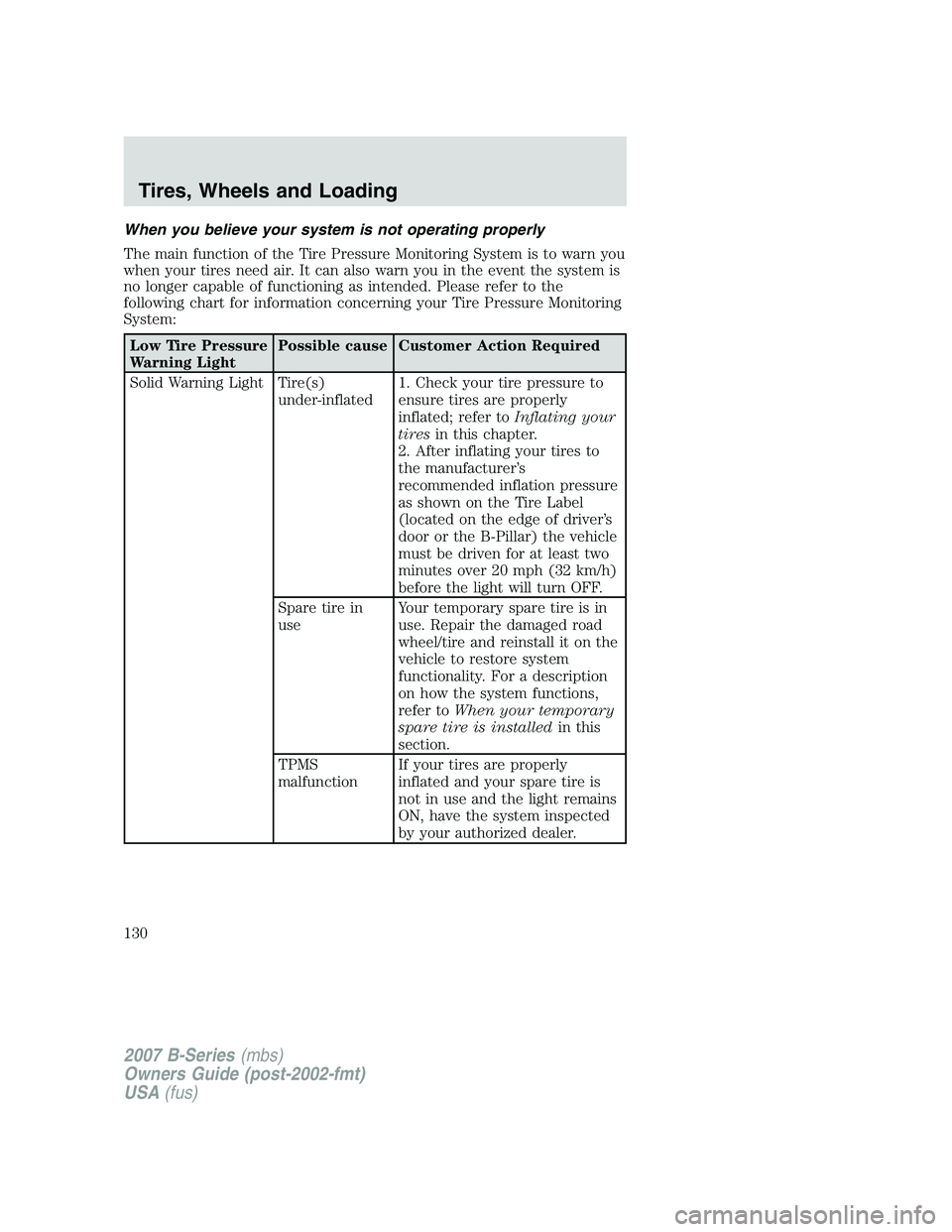
When you believe your system is not operating properly
The main function of the Tire Pressure Monitoring System is to warn you
when your tires need air. It can also warn you in the event the system is
no longer capable of functioning as intended. Please refer to the
following chart for information concerning your Tire Pressure Monitoring
System:
Low Tire Pressure
Warning LightPossible cause Customer Action Required
Solid Warning Light Tire(s) under-inflated1. Check your tire pressure to
ensure tires are properly
inflated; refer to
Inflating your
tires in this chapter.
2. After inflating your tires to
the manufacturer’s
recommended inflation pressure
as shown on the Tire Label
(located on the edge of driver’s
door or the B-Pillar) the vehicle
must be driven for at least two
minutes over 20 mph (32 km/h)
before the light will turn OFF.
Spare tire in
use Your temporary spare tire is in
use. Repair the damaged road
wheel/tire and reinstall it on the
vehicle to restore system
functionality. For a description
on how the system functions,
refer to
When your temporary
spare tire is installed in this
section.
TPMS
malfunction If your tires are properly
inflated and your spare tire is
not in use and the light remains
ON, have the system inspected
by your authorized dealer.
2007 B-Series
(mbs)
Owners Guide (post-2002-fmt)
USA (fus)
Tires, Wheels and Loading
130
Page 131 of 280

Low Tire Pressure
Warning LightPossible cause Customer Action Required
Flashing Warning
Light Spare tire in
useYour temporary spare tire is in
use. Repair the damaged road
wheel and re-mount it on the
vehicle to restore system
functionality. For a description
of how the system functions
under these conditions, refer to
When your temporary spare
tire is intalled
in this section.
TPMS
malfunction If your tires are properly
inflated and your spare tire is
not in use and the TPMS
warning light is still ON, have
the system inspected by your
authorized dealer.
When inflating your tires
When putting air into your tires (such as at a gas station or in your
garage), the Tire Pressure Monitoring System may not respond
immediately to the air added to your tires.
It may take up to two minutes of driving over 20 mph (32 km/h) for the
light to turn OFF after you have filled your tires to the recommended
tire pressure.
How temperature affects your tire pressure
The Tire Pressure Monitoring System (TPMS) monitors tire pressure in
each pneumatic tire. While driving in a normal manner, a typical passenger
tire inflation pressure may increase approximately 2 to 4 psi (14 to 28
kPa) from a cold start situation. If the vehicle is stationary over night with
the outside temperature significantly lower than the daytime temperature,
the tire pressure may decrease approximately 3 psi (20.7 kPa) for a drop
of 30° F (16.6° C) in ambient temperature. This lower pressure value may
be detected by the TPMS as being lower than the recommended inflation
pressure and activate the TPMS warning for low tire pressure. If the low
tire pressure warning light is ON, visually check each tire to verify that no
tire is flat. If one or more tires are flat, repair as necessary. Check air
pressure in the road tires. If any tire is underinflated, carefully drive the
vehicle to the nearest location where air can be added to the tires. Inflate
all the tires to the recommended inflation pressure.
2007 B-Series (mbs)
Owners Guide (post-2002-fmt)
USA (fus)
Tires, Wheels and Loading
131
Page 181 of 280
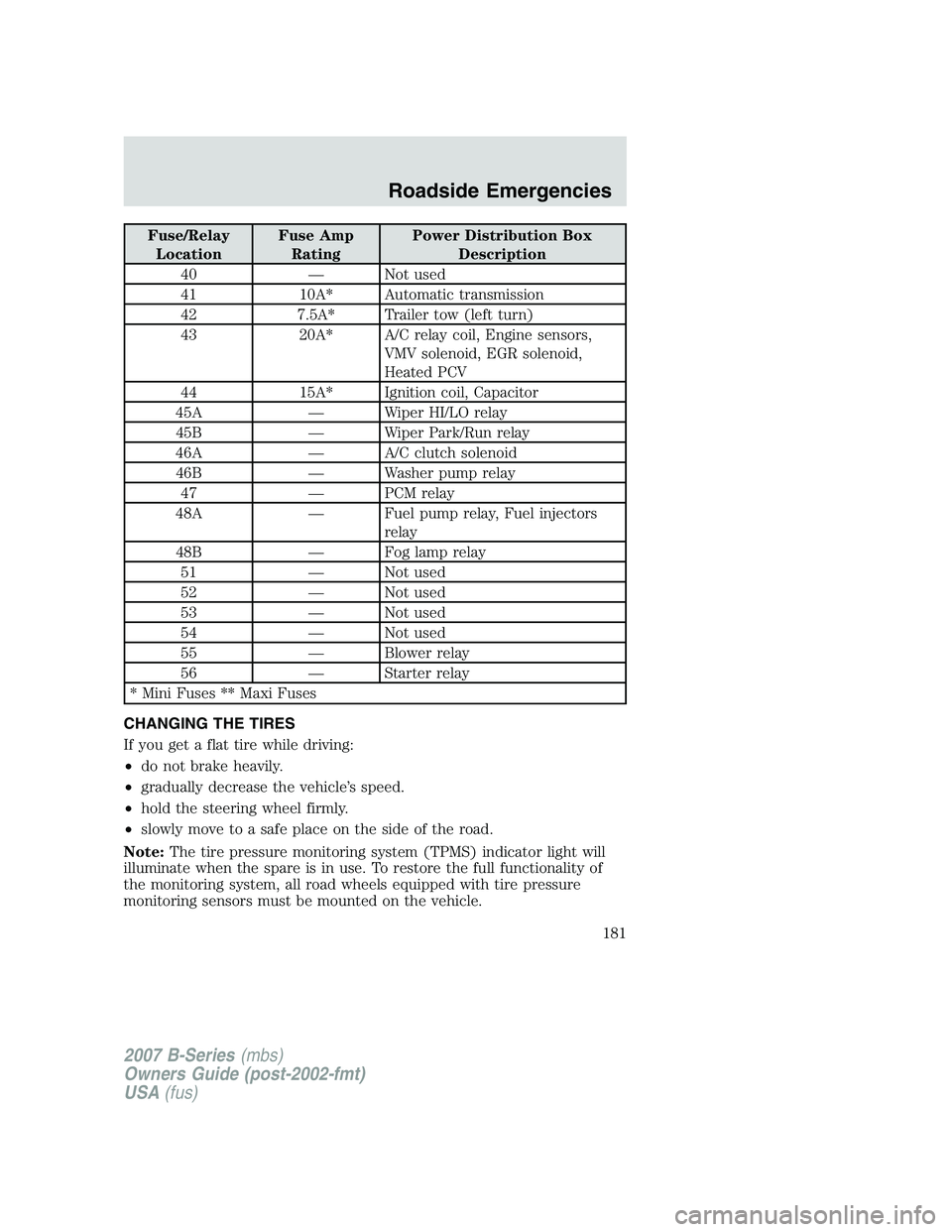
Fuse/RelayLocation Fuse Amp
Rating Power Distribution Box
Description
40 — Not used
41 10A* Automatic transmission
42 7.5A* Trailer tow (left turn)
43 20A* A/C relay coil, Engine sensors,
VMV solenoid, EGR solenoid,
Heated PCV
44 15A* Ignition coil, Capacitor
45A — Wiper HI/LO relay
45B — Wiper Park/Run relay
46A — A/C clutch solenoid
46B — Washer pump relay
47 — PCM relay
48A — Fuel pump relay, Fuel injectors
relay
48B — Fog lamp relay
51 — Not used
52 — Not used
53 — Not used
54 — Not used
55 — Blower relay
56 — Starter relay
* Mini Fuses ** Maxi Fuses
CHANGING THE TIRES
If you get a flat tire while driving:
• do not brake heavily.
• gradually decrease the vehicle’s speed.
• hold the steering wheel firmly.
• slowly move to a safe place on the side of the road.
Note: The tire pressure monitoring system (TPMS) indicator light will
illuminate when the spare is in use. To restore the full functionality of
the monitoring system, all road wheels equipped with tire pressure
monitoring sensors must be mounted on the vehicle.
2007 B-Series (mbs)
Owners Guide (post-2002-fmt)
USA (fus)
Roadside Emergencies
181
Page 182 of 280
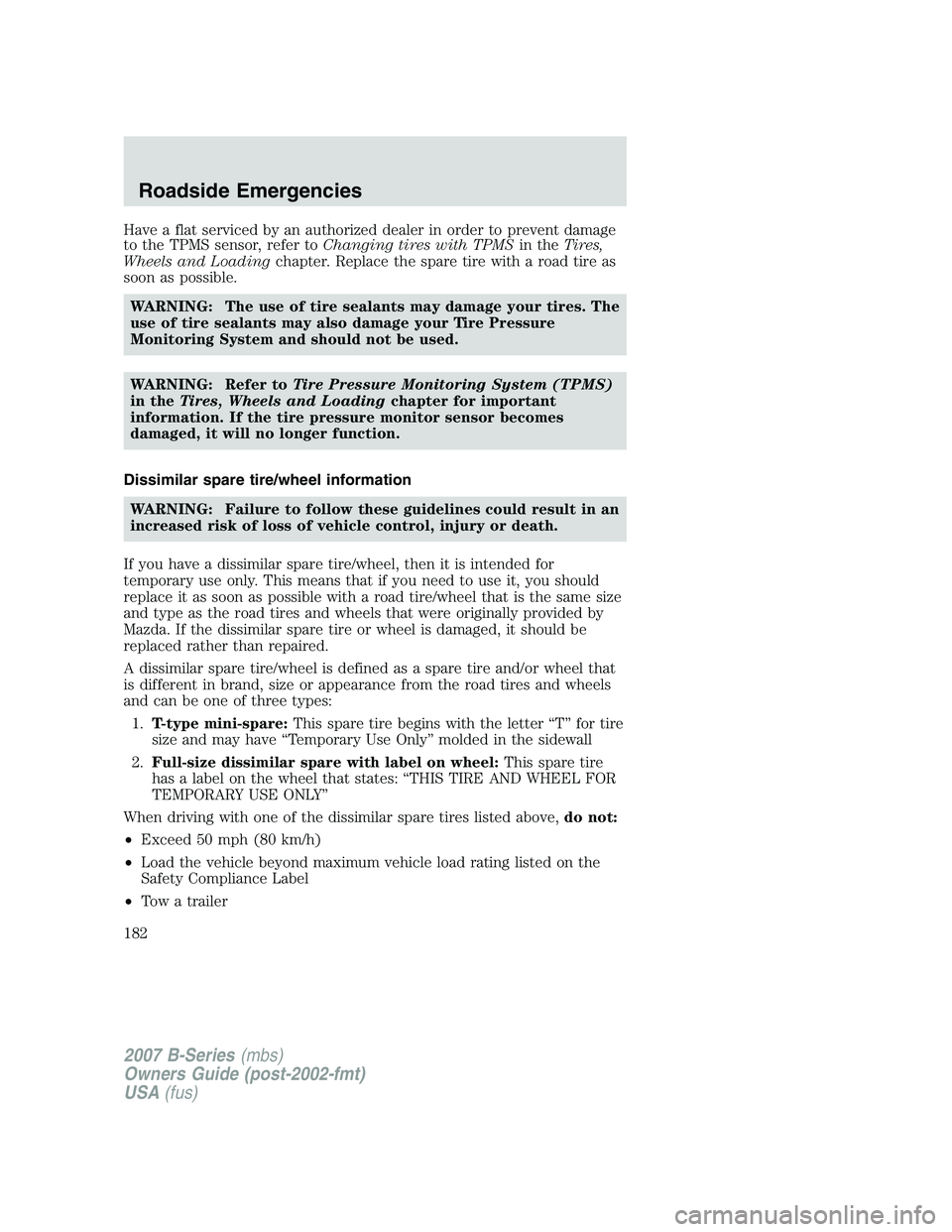
Have a flat serviced by an authorized dealer in order to prevent damage
to the TPMS sensor, refer toChanging tires with TPMSin theTires,
Wheels and Loading chapter. Replace the spare tire with a road tire as
soon as possible.
WARNING: The use of tire sealants may damage your tires. The
use of tire sealants may also damage your Tire Pressure
Monitoring System and should not be used.
WARNING: Refer to Tire Pressure Monitoring System (TPMS)
in the Tires, Wheels and Loading chapter for important
information. If the tire pressure monitor sensor becomes
damaged, it will no longer function.
Dissimilar spare tire/wheel information WARNING: Failure to follow these guidelines could result in an
increased risk of loss of vehicle control, injury or death.
If you have a dissimilar spare tire/wheel, then it is intended for
temporary use only. This means that if you need to use it, you should
replace it as soon as possible with a road tire/wheel that is the same size
and type as the road tires and wheels that were originally provided by
Mazda. If the dissimilar spare tire or wheel is damaged, it should be
replaced rather than repaired.
A dissimilar spare tire/wheel is defined as a spare tire and/or wheel that
is different in brand, size or appearance from the road tires and wheels
and can be one of three types: 1. T-type mini-spare: This spare tire begins with the letter “T” for tire
size and may have “Temporary Use Only” molded in the sidewall
2. Full-size dissimilar spare with label on wheel: This spare tire
has a label on the wheel that states: “THIS TIRE AND WHEEL FOR
TEMPORARY USE ONLY”
When driving with one of the dissimilar spare tires listed above, do not:
• Exceed 50 mph (80 km/h)
• Load the vehicle beyond maximum vehicle load rating listed on the
Safety Compliance Label
• Tow a trailer
2007 B-Series (mbs)
Owners Guide (post-2002-fmt)
USA (fus)
Roadside Emergencies
182
Page 184 of 280
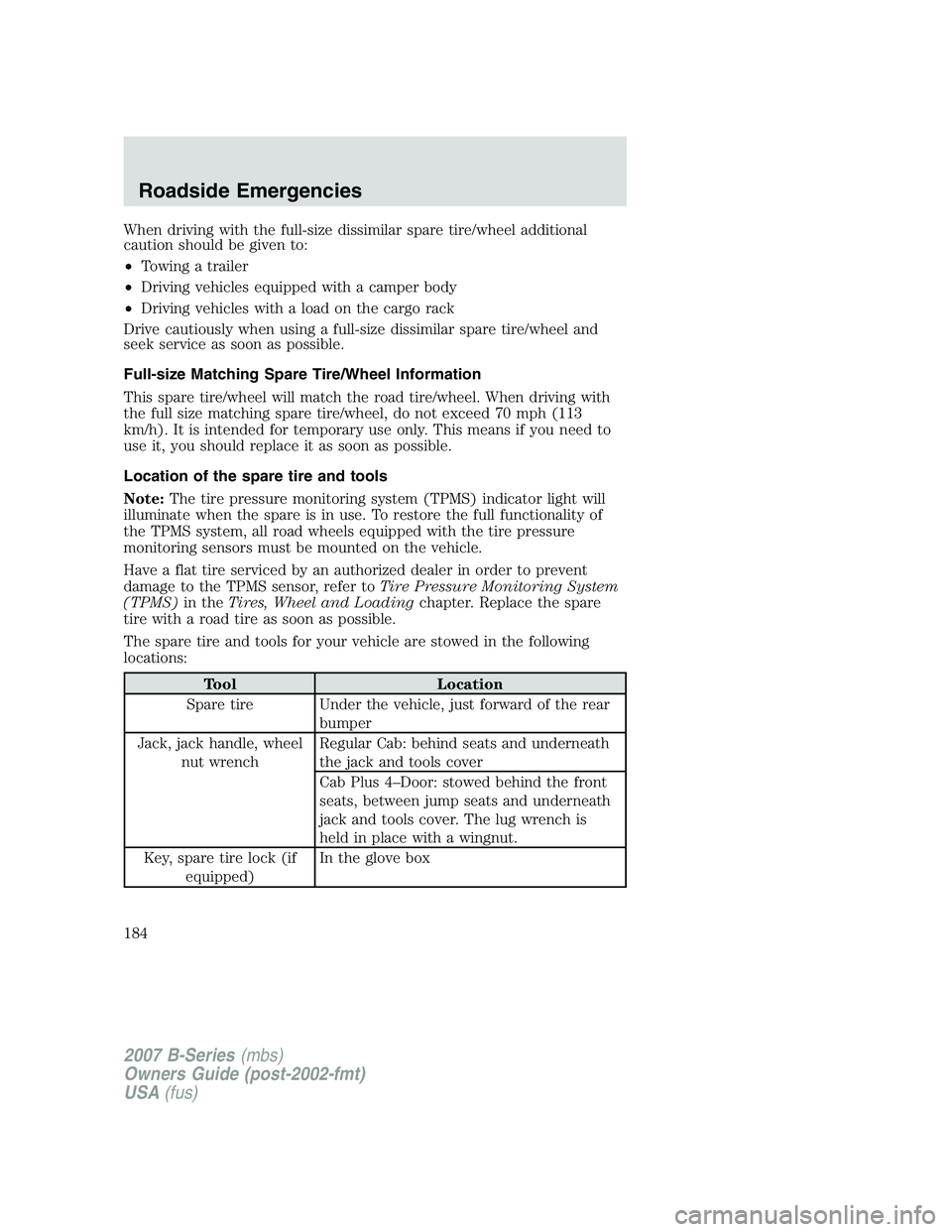
When driving with the full-size dissimilar spare tire/wheel additional
caution should be given to:
•Towing a trailer
• Driving vehicles equipped with a camper body
• Driving vehicles with a load on the cargo rack
Drive cautiously when using a full-size dissimilar spare tire/wheel and
seek service as soon as possible.
Full-size Matching Spare Tire/Wheel Information
This spare tire/wheel will match the road tire/wheel. When driving with
the full size matching spare tire/wheel, do not exceed 70 mph (113
km/h). It is intended for temporary use only. This means if you need to
use it, you should replace it as soon as possible.
Location of the spare tire and tools
Note: The tire pressure monitoring system (TPMS) indicator light will
illuminate when the spare is in use. To restore the full functionality of
the TPMS system, all road wheels equipped with the tire pressure
monitoring sensors must be mounted on the vehicle.
Have a flat tire serviced by an authorized dealer in order to prevent
damage to the TPMS sensor, refer to Tire Pressure Monitoring System
(TPMS) in theTires, Wheel and Loading chapter. Replace the spare
tire with a road tire as soon as possible.
The spare tire and tools for your vehicle are stowed in the following
locations:
Tool Location
Spare tire Under the vehicle, just forward of the rear bumper
Jack, jack handle, wheel nut wrench Regular Cab: behind seats and underneath
the jack and tools cover
Cab Plus 4–Door: stowed behind the front
seats, between jump seats and underneath
jack and tools cover. The lug wrench is
held in place with a wingnut.
Key, spare tire lock (if equipped) In the glove box
2007 B-Series
(mbs)
Owners Guide (post-2002-fmt)
USA (fus)
Roadside Emergencies
184
Page 273 of 280
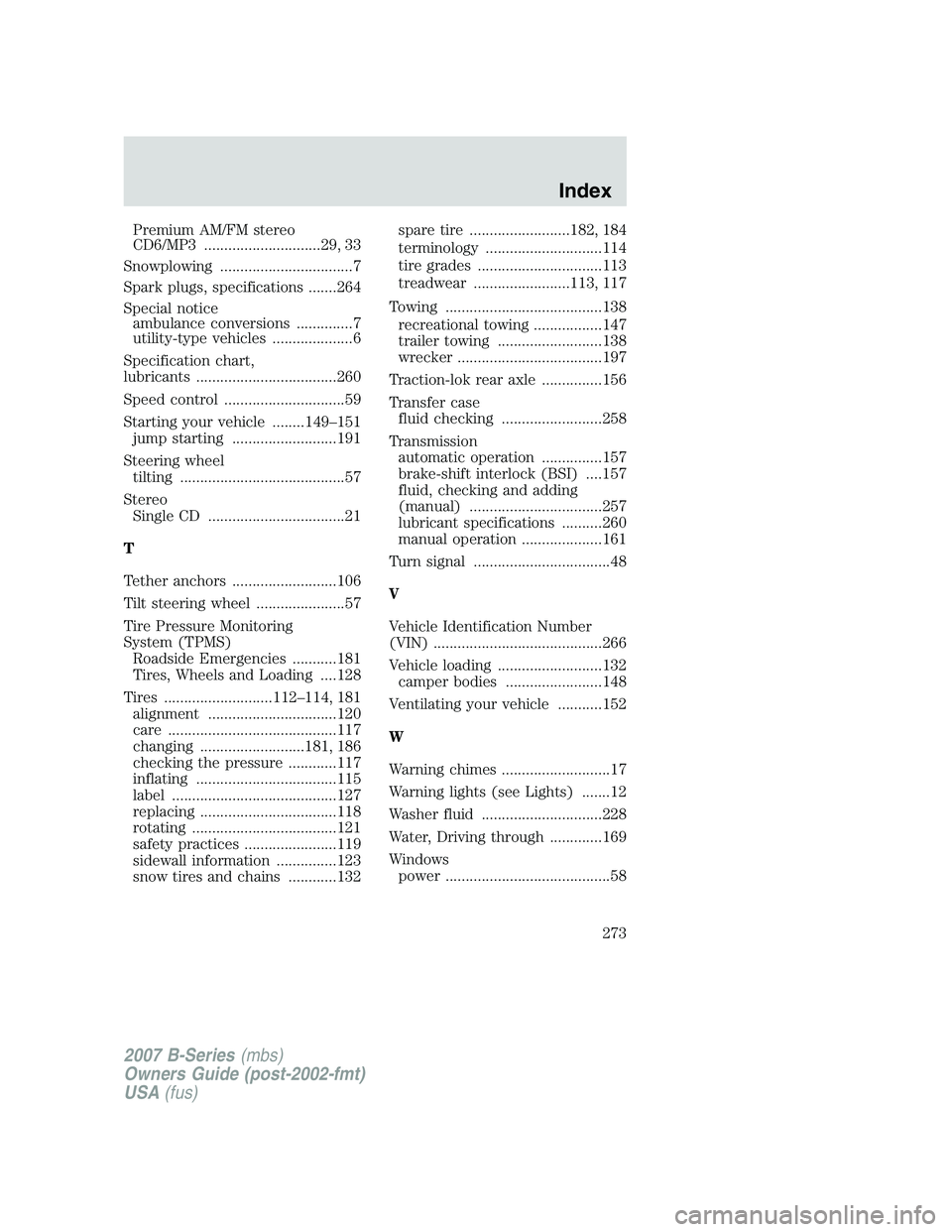
Premium AM/FM stereo
CD6/MP3 .............................29, 33
Snowplowing .................................7
Spark plugs, specifications .......264
Special notice ambulance conversions ..............7
utility-type vehicles ....................6
Specification chart,
lubricants ...................................260
Speed control ..............................59
Starting your vehicle ........149–151 jump starting ..........................191
Steering wheel tilting .........................................57
Stereo Single CD ..................................21
T
Tether anchors ..........................106
Tilt steering wheel ......................57
Tire Pressure Monitoring
System (TPMS) Roadside Emergencies ...........181
Tires, Wheels and Loading ....128
Tires ...........................112–114, 181 alignment ................................120
care ..........................................117
changing ..........................181, 186
checking the pressure ............117
inflating ...................................115
label .........................................127
replacing ..................................118
rotating ....................................121
safety practices .......................119
sidewall information ...............123
snow tires and chains ............132 spare tire .........................182, 184
terminology .............................114
tire grades ...............................113
treadwear ........................113, 117
Towing .......................................138 recreational towing .................147
trailer towing ..........................138
wrecker ....................................197
Traction-lok rear axle ...............156
Transfer case fluid checking .........................258
Transmission automatic operation ...............157
brake-shift interlock (BSI) ....157
fluid, checking and adding
(manual) .................................257
lubricant specifications ..........260
manual operation ....................161
Turn signal ..................................48
V
Vehicle Identification Number
(VIN) ..........................................266
Vehicle loading ..........................132 camper bodies ........................148
Ventilating your vehicle ...........152
W
Warning chimes ...........................17
Warning lights (see Lights) .......12
Washer fluid ..............................228
Water, Driving through .............169
Windows power .........................................58
2007 B-Series (mbs)
Owners Guide (post-2002-fmt)
USA (fus)
Index
273